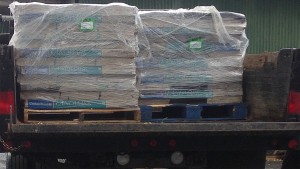Little Fire Ant Intercepted in Hāna

Little Fire Ant infested shingles. Photo credit: Maui Invasive Species Committee.
Thanks to an alert landscaper, Hāna has been protected from an infestation of the little fire ant, according to new information released today by the Maui Invasive Species Committee.
According to the MISC, a landscaper was delivering two pallets of roofing shingles to a residence in Hāna on Tuesday, March 1; but because he knew the shingles had come from Hilo, he stopped at his baseyard to test for little fire ants or “LFA” using a stick smeared with peanut butter.
When he returned after an hour, he reportedly found small orange ants covering the peanut butter-smeared sticks. He reported the finding to Maui Invasive Species Committee staff at its Hāna field station.

Little Fire Ant infested shingles. Photo credit: Maui Invasive Species Committee.
Invasive plant supervisor Mike Ade and his crew immediately went to the site, collected samples, and determined they were little fire ants. “We even did the sting test: holding ants in the fold of our elbow to see if they would sting,” saod Ade.
Ade tracked down an appropriate pesticide and started controlling the next day, treating all 1600 asphalt shingles individually, front and back, as well as the truck that carried the pallets and the area where the landscaper had parked.
“This most recent arrival of LFA on Maui highlights just how easily these ants can move between islands. They can infest almost anything that has been stored outside,” explained MISC manager Teya Penniman.
Left long enough, garden hoses, weed mats, lumber and building materials can become infested. “It was obvious they (the shingles) had been outside for a while; there was moss, mold, and plants growing on them,” says Christian Visoria, part of the MISC crew that helped to treat the shingles. “It makes you think about what else is out there being shipped between islands.”
Kyle Yagi, supervisor with the Maui Plant Quarantine Branch, explained that the Hawaiʻi Department of Agriculture can’t inspect all incoming cargo. While their mandate covers agricultural materials they do inspect other high risk items, time permitting; vehicles shipped from infested areas are one priority.
Despite the recent discovery, Maui HDOA inspectors are seeing a decline in shipments of produce and plant material containing little fire ants, according to the MISC.
Several years ago, LFA were intercepted weekly, but lately it’s been less than once per month, according to the MISC. “Shippers are better educated about LFA,” said Yagi. “They don’t want to lose their shipment so they’re trying to clean it up.” Many products that tended to carry LFA such as rambutan are simply not shipped.
As little fire ants continue to spread on Hawaiʻi Island, the risk of movement between islands will increase. Penniman emphasized the importance of public awareness and reporting. “What happened in Hāna was a heroic response to a bad situation: the landscaper, who prefers to remain anonymous, quarantined and tested for little fire ants before even unloading the shipment. His actions along with the rapid response by the MISC crew protected the whole community.”
Find resources and testing information at stoptheant.org and littlefireants.com










